ELIPHAS LEVI:
Eliphas Levi was a famous French occultist of the 19th century.
According to R.A. Gilbert in the preface of "Mysteries of the Qabalah",
Eliphas Levi was a Freemason: "...earlier in 1861, on March 14, he had
been initiated in the Lodge Rose du parfait Silence, under the
Grand Orient of France." ("Mysteries of the Qabalah", Eliphas Levi,
WEISER BOOKS, page 10) In the same book, we read that "1961 is the year
in which Levi became a mason, and being a freemason meant for Levi:
outlining the original purpose of the fraternity, bringing back
the lost traditions, and proving that the Qabalah was the root of
masonic symbolism." (page 16)
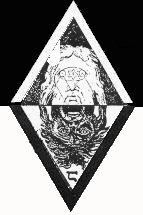 Though his real name was Louis Constant, he's better known by his nom de
plume Eliphas Levi. Some Freemasonic web sites deny his membership in
Freemasonry, while others use the regular dodge that, although he was a
Though his real name was Louis Constant, he's better known by his nom de
plume Eliphas Levi. Some Freemasonic web sites deny his membership in
Freemasonry, while others use the regular dodge that, although he was a
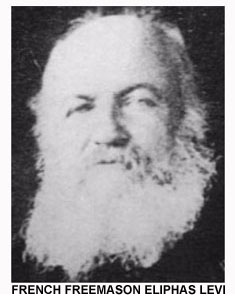 Mason of sorts, he belonged to an irregular lodge, from which fact we
may gather that, due to his known involvment in necromancy, sorcery,
magic, etc., some Freemasons would like to disavow his membership,
since it might taint the august opinion that they evidently have of
their brotherhood. In any case, it`'s known that Albert Pike, one of
Masonry's greatest human icons, in his magnum
opus, "Morals and Dogma", plagiarized Eliphas Levi extensively.
Mason of sorts, he belonged to an irregular lodge, from which fact we
may gather that, due to his known involvment in necromancy, sorcery,
magic, etc., some Freemasons would like to disavow his membership,
since it might taint the august opinion that they evidently have of
their brotherhood. In any case, it`'s known that Albert Pike, one of
Masonry's greatest human icons, in his magnum
opus, "Morals and Dogma", plagiarized Eliphas Levi extensively.
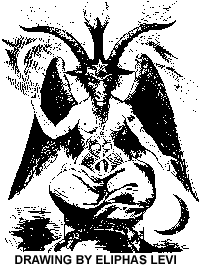 Some anti-Catholics, on the other hand, are pleased to note that Levi was
an ordained deacon in the Roman Catholic Church, thus sharing with
Adolf Hitler an association, however brief or tenuous, with
Catholicism. However, since he was expelled from the seminary of Saint-Sulpice
for teaching heretical doctrines, he was ipso facto not a Catholic because,
according to Catholic doctrine, a heretic, by definition, cannot be a member of the Catholic
Church. What's more, as a Freemason, he would automatically be excommunicated
from the Catholic Church for his association with Freemasonry. Even so, he allegedly
considered himself a faithful son of the Church until his death.
Some anti-Catholics, on the other hand, are pleased to note that Levi was
an ordained deacon in the Roman Catholic Church, thus sharing with
Adolf Hitler an association, however brief or tenuous, with
Catholicism. However, since he was expelled from the seminary of Saint-Sulpice
for teaching heretical doctrines, he was ipso facto not a Catholic because,
according to Catholic doctrine, a heretic, by definition, cannot be a member of the Catholic
Church. What's more, as a Freemason, he would automatically be excommunicated
from the Catholic Church for his association with Freemasonry. Even so, he allegedly
considered himself a faithful son of the Church until his death.
In 1825 Levi began studying the occult, and he wrote about that subject
for the next three decades and authored many esoteric works, such
as "Trancendental Magic", "The Great Secret", "The History of Magic",
and "The Mysteries of the Qabalah", etc. Born in 1810, he died in 1875.
According to John Daniel, Levi had the priviledge
of studying, as a translator, rare occult texts taken by Freemason Bonaparte from the
Vatican, from whence he evidently gathered much of his rare occult
knowlege. It's interesting, then, that Freemason and Kabbalist,
Eliphas Levi, who cannot be discredited by alleging that his work is tainted
with partisan Catholic ideology, admits that the Templars were
involved
in magic, and his work, including the famous drawing of the
baphomet, allegedly an icon worshiped by the Templars, captured the
fascination of serial killer David Berkowitz,
who was convicted
in the Son of Sam cult killings.
Both the Son of Sam,
David Berkowitz, and Jack the Ripper,
supposedly D'Onston, a man who had fought for Freemason Girabaldi,
studied the work of
Eliphas Levi.
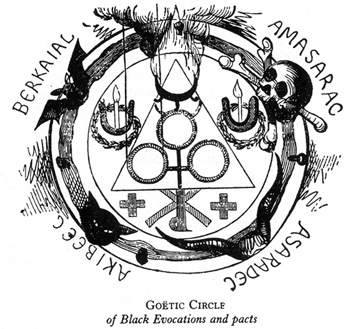
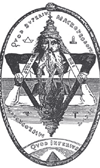
[Drawing by Eliphas Levi of Solomon's Seal as the white and black Jehovah; above,
Goetic Circle used by the Son of Sam Cult.]